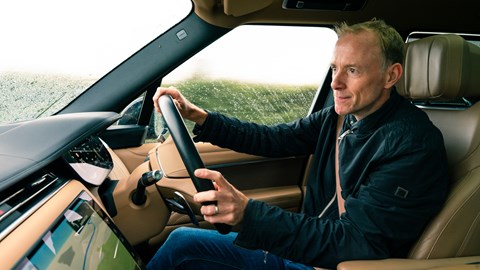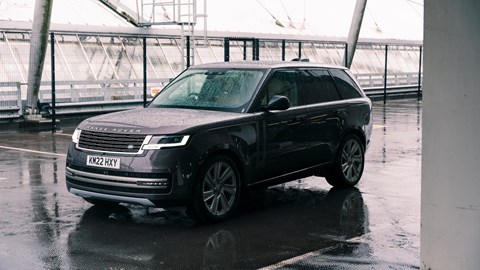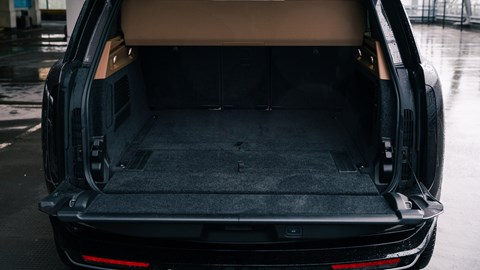► We live with the new Range Rover
► This month: we talk through the specs
► It’s a diesel!
Is this peak Range Rover? There’s a lot of love for the L322 Rangie developed on BMW’s watch; I ran a V8 in 2003. The first aluminium model’s CAR tour of duty took in my 2013 wedding; our L405 was a TDV6. Now, 10 years on, the fifth-generation L460 has joined the fleet.
Tip this model into its first brisk corner and you know this is a Range Rover like no other. Shuffling the steering wheel feels effortless and genteel but turn-in is remarkably direct, surprisingly so at first. Thank the standard all-wheel steering, which can add up to 7.3˚ of opposing angle at the rear.

The latest Rangie is packed with new technologies. Again we’ve gone for a diesel, but these days it’s a silky inline-six with mild-hybrid assistance, feeding ancillaries such as the power steering and dishing up a torque boost during acceleration. There are two diesels: the D300 with 296bhp and 479lb ft of torque or our D350, with 345bhp and 516lb ft.
Floor it and our car swats the 0-62mph sprint in 6.1sec. I’m not choosing to excessively tap those prodigious outputs, though, in a bid to get close to the D350’s 37.2mpg. It’s working: the first month returned a promising 35.8mpg, and topped 40 on gentle motorway runs. A decade ago, the TDV6 averaged 31mpg.
Electronically controlled air suspension is nothing new but this time comes with twin valve dampers, as this Rangie has an unprecedented emphasis on dynamics. So it monitors your location to prime the suspension for the upcoming corner. Of course it still rolls, but body control is hugely improved: fast corners that made the L405 wallow fearfully now feel much more composed. Ride height drops 16mm at highway speeds to improve aerodynamics, and squat mode – a 5cm drop to make getting in and out easier – is now automatic.

The new Range Rover lineup starts at £103,730 for a short-wheelbase D300 SE. It runs on 21-inch wheels, and key standard equipment includes Windsor leather interior, glass roof panel, a laminated windscreen to keep the cabin quiet keyless entry and soft door close (a boon because our L405’s had an irritating habit of not closing entirely).
Every Range Rover gets an active locking rear differential, to help manage power delivery across the rear axle. Hastily pull out of a junction and you feel the rear bias, though the intelligent all-wheel-drive system readily brings the fronts into play. Naturally there are high and low-range gears for off-roading, LED headlamps with variable light patterns and a ton more safety kit.
We have the punchier D350 diesel engine (add £3100) and climbed one rung up the ladder to HSE spec. Upgrades include 22-inch Style alloys with seven chunky spokes, semi-aniline leather (with dye deeply absorbed into the hide), cooling function seats front and rear, illuminated seat buckles (surprisingly helpful at night, especially when leaning over child seats) and a Meridian 3D sound system.

There’s also something called Cabin Air Purification Pro which treats the cockpit for allergens, odours, viruses and tailpipe nasties. It uses advanced Panasonic Nanoe X
technology which Tony Stark presumably invented; I’m going to have to talk to JLR’s in-house Avengers to understand this.
This Range Rover generation comes with a choice of two lengths and four-, five- or seven-seat options. We’ve got the standard rear bench in a cabin clad in caramel-coloured leather, with a £1500 SV extension over areas including the door tops and centre console. Walnut veneer is standard but our car instead has silver birch for £385, and £215 SV Bespoke carpet mats.
This Rangie is largely free from exterior embellishments, as befits the ultra-clean design. There’s no £950 contrasting roof paint nor Shadow pack which blacks out the lower grille and darkens the side ‘U’ graphic, nor did we treat ourselves to black-painted front brake calipers (£305), laminated side glass (£275) and rear privacy glass (£475). However, the understated is it-brown colour is actually Charente Grey, an £865 premium metallic. Oh, and we ticked the boxes for a few other bits and pieces… and by the time we’d finished, they’d added £15k to the price.

The boot is massive (725 litres) but is bisected by a £150 auto-folding loadspace cover.
While watching the solid shelf retract is poetic engineering, I was soon wading through the online manual to find out how to remove it to stow the camping gear. There must be a way! I can also partition the boot with the £650 versatile loadspace floor. With £13,585 of options and a stonking £1420 for VED (no surprise given CO2 emissions are a thought-provoking 207g/km) the final price is £128,180. That’s the entry fee for Range Rover’s house of luxury.
Over the next five months we’ll assess if it’s worth every penny.
Logbook: Logbook: Range Rover D350 HSE (Month 1)
Price £113,120 (£128,180 as tested)
Performance 2997cc turbodiesel six-cylinder, 345bhp, 516lb ft, 6.1sec 0-62mph, 145mph
Efficiency 37.2mpg (official), 35.8mpg (tested), 207g/km CO2
Energy cost 18.0p per mile
Miles this month 1741
Total miles 13,460